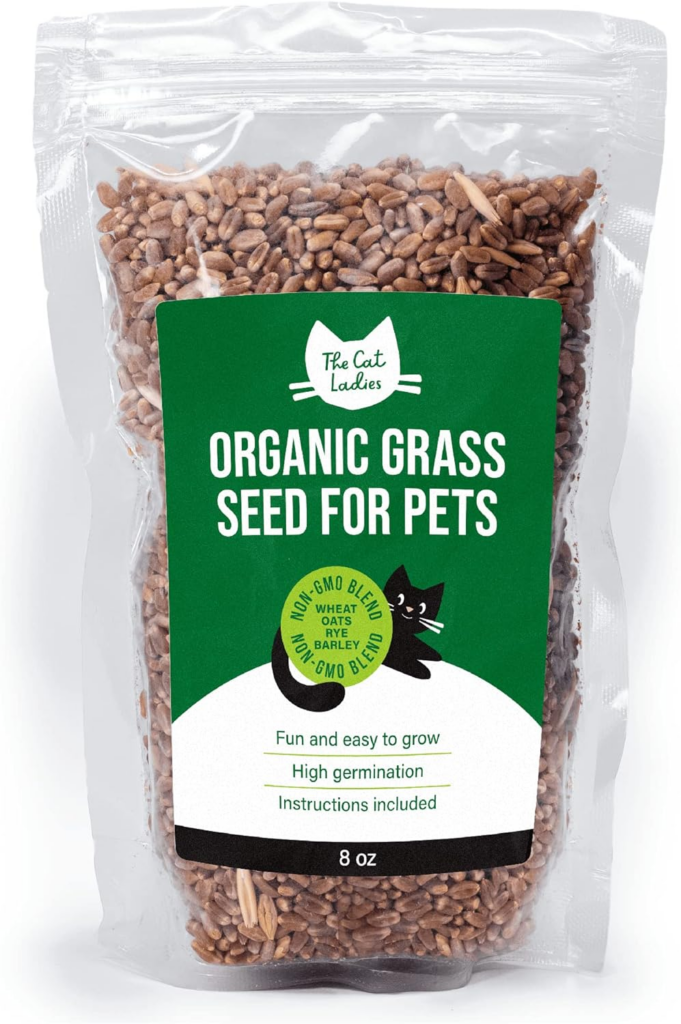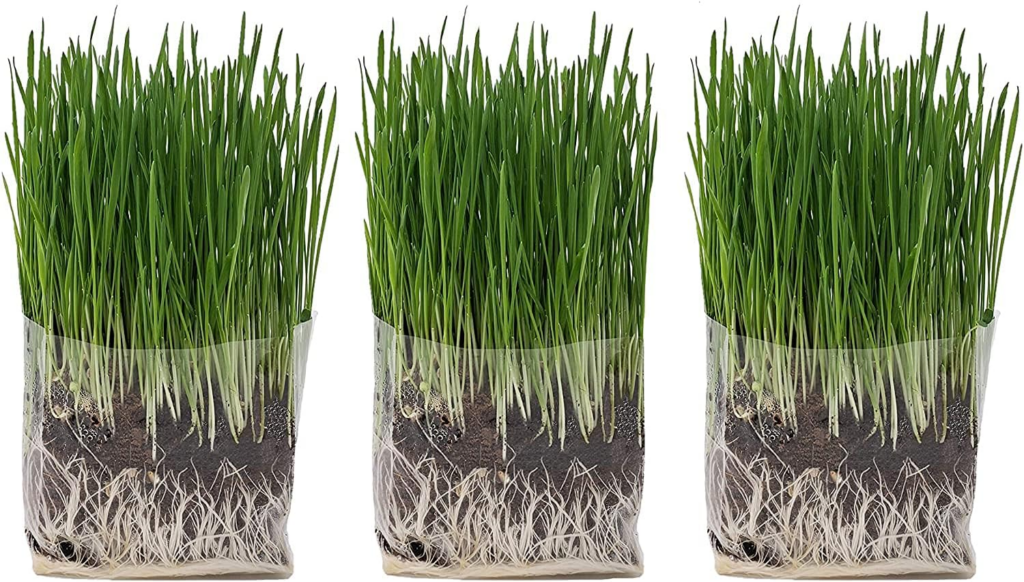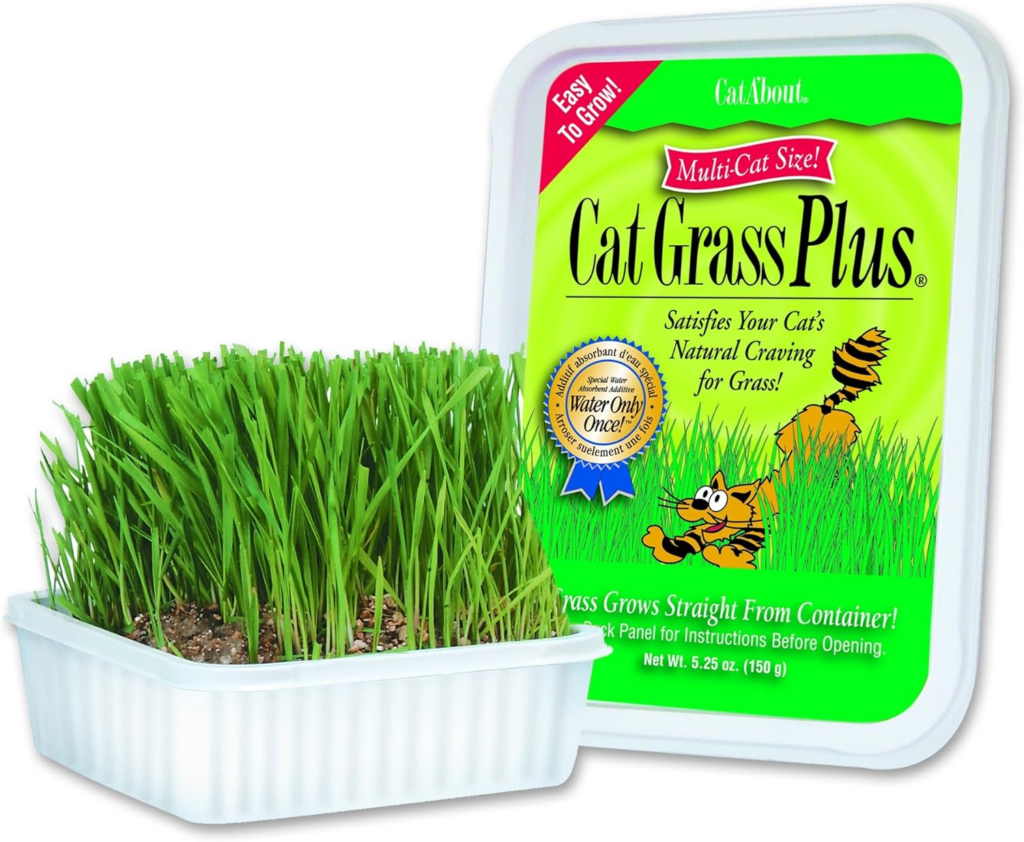Key Points
- Cat grass is a blend of cereal grasses that are all safe for your cat to munch on, though don’t be surprised if they vomit the grass.
- This all-natural snack offers cats a few nutritional benefits, including fiber, folic acid, and vitamin A.
- Make sure to maintain your cat grass to keep it fresh and avoid mold growth.
Ever wondered about those tufts of grass at your local pet shop? It’s called cat grass, and many cats really love it. We’re not talking about catnip levels of love, but many kitties do seem to enjoy it.
Given the fact that cats are obligate carnivores designed for a meat-dominant diet, it seems unlikely that grass would be so enticing to them. But cat grass has an undeniable appeal to curious cats, and it can even provide your kitty with some health benefits. Oddly enough, that’s true even though many kitties vomit the grass soon after eating it.
If you’ve seen your cat chewing on grass and other plants, then cat grass is a safe addition to their diet. Whether you have an indoor cat or an outdoor cat, many plants are extremely toxic to cats. This is a much safer way to satisfy their plant-nibbling cravings.
Let’s dive into all things cat grass and see why adding it to your cat’s diet may be a good idea. Plus, if you’re interested in growing your own at home, we’ll share a few popular cat grass kits to get you started.
What is cat grass?
Cat grass is a blend of cereal grasses that includes oat grass, barley grass, ryegrass, flax grass, and wheatgrass. These plants offer nutrients such as vitamins A and D, trace minerals, and fiber.
There isn’t a lot of science explaining why your cat likes to nibble on grass, but the habit likely began with their wild ancestors. Because cats can’t lack the enzymes needed to fully digest plant materials, they often vomit after ingesting plants. It’s believed that eating plants helps them expel (a polite way of saying vomit) parasites, fur, and any indigestible materials they’ve recently eaten. While the aftereffects may be gross, eating cat grass isn’t necessarily a sign of illness in our modern-day kitties, and some pet owners choose to grow their own grass at home.
Most grasses grow within seven days of planting. The first growth cycle of any pet grass will have the most nutrients, which is why pet owners buy them or grow them in rotating cycles. Once the grass becomes wilted or yellow, it no longer provides beneficial nutrients.
What are the health benefits for your kitty?
Your kitties aren’t able to digest grass. They often expel it pretty quickly after it’s ingested. However, it still offers important health benefits beyond expelling parasites or hair.
For example, the fiber found in cat grass works as a natural laxative and prevents constipation. It can also help prevent hairballs.
Chewing grass can also be a fun and stimulating activity for your cat, helping to combat boredom.
What are the disadvantages of cat grass?
Before introducing anything new to your cat’s diet, it’s always a good idea to know about any potential disadvantages. In this case, the key advantage and disadvantage are the same — they can throw up if they eat too much.
Maintaining your plant is also important, as mold can grow on the grass. If your cat ingests even a small amount of mold, they can show signs of food poisoning within 30 minutes.
Lastly, your cat may not care, but if they do vomit, you’ll need to quickly clean up the mess to avoid ruining your carpets and rugs.
How should you offer cat grass to your kitty?
To share this plant, cut the tips of the blades and add them directly to your cat’s food. Or, offer it to them out of the palm of your hand just like any other treat. They can also eat it directly from the container, but make sure to watch them when they do. They may try to chew on the pot or eat the dirt in it instead.
If your kitty seems a little hesitant at first, try spraying or sprinkling a little water on the tips of the blades. They may initially lick the water, then decide to try the grass.
Before you plant a lot, keep in mind that some cats don’t enjoy it. But if you find your kitty gravitating toward real grass, you may want to give it a shot.
Keep in mind, however, that cat grass is considered a treat, even if it does offer potential health benefits. And overall, treats shouldn’t make up more than 10% of your kitty’s caloric intake.
How to grow cat grass at home
If you have a green thumb, you can find plenty of cat grass kits for sale online and in pet stores. Just be sure to separate this edible plant from the rest of your houseplants (and be aware of potentially poisonous plants for pets) so there’s no confusion about which plants your kitty can munch on.

Here’s how to grow your own cat grass from seeds in five steps:
- Fill shallow pots with potting soil. Use pots that are heavier and not as prone to tipping over when cats tug on the grass.
- Add the seeds to the pot and cover with a quarter-inch of soil.
- Spritz or wet the soil and keep it moist until the plants sprout in 3-7 seven days. It should be damp but not soaked. After sprouting, use less water.
- Once the grass has sprouted, place the container onto a bright windowsill or in a sunny location in your yard; water daily with a spray bottle.
- When the grass is 4 inches tall, it’s ready for your cat.
Cat grass should last for 10-14 days. To keep a constant supply of fresh grass, sow new seeds every 1-2 weeks and rotate the old, wilted, or yellowed grass out. Make sure to keep the soil slightly moist but not wet. Mold can develop when grasses are over-watered.
Look for aphids or nematodes on the surface of the plant or soil. Use natural remedies to treat them, or throw the plants out and start new ones in clean pots.
Best cat grass products
You don’t need a green thumb to grow grass. Pet stores and popular online retailers (like Amazon) sell ready-to-grow cat grass kits and seeds. Here are a few popular options to get you started:
The Cat Ladies 100% Organic Cat Grass Seed

These seeds are non-GMO and grow into a grass blend of wheat, oat, rye, and barley. This grass provides a healthy snack loaded with vitamins A, B, and C. Each bag comes with a year’s supply.
The Cat Ladies Grow Bag Kit

If you’re a first-time grower, you may want to try a kit like this one. It comes with soil disks, locally sourced seeds, and BPA-free grow bags, along with instructions and growing tips.
Cat-A’bout Cat Grass For Indoor Cats

This popular cat grass kit is also a great option for newbies. You only need to water it once and set it in the sunlight, and you should have shoots ready for your kitty in just one week.
Should you give your kitty cat grass?
Many cats love munching on grass, and cat grass is the perfect way to help them do this safely. But every cat is different, and it’s important to be prepared when introducing a treat (even a healthy one) into your kitty’s diet.
It’s always smart to check with your vet before sharing a new treat. And as your cat grows up, having a pet insurance plan in place is a good way to make sure your kitty is protected from life’s little accidents.
Updated on Feb. 10, 2025: A previous version of this article stated that “The chlorophyll in the grass helps to freshen your kitty’s breath.” After consulting with a veterinarian, we no longer believe this is accurate, and so we have removed this language.
FAQs
- https://vetmed.tamu.edu/news/pet-talk/eating-your-greens-the-basics-of-cat-grass/
- https://www.ncbi.nlm.nih.gov/pmc/articles/PMC8300339/
- https://www.science.org/content/article/mystery-solved-why-cats-eat-grass
- https://thecatladies.com/blogs/news/how-do-i-grow-cat-grass
- https://vcahospitals.com/know-your-pet/summer-toxins-to-avoid-with-your-pet
- https://vcahospitals.com/know-your-pet/cat-treats
- https://vcahospitals.com/know-your-pet/where-the-green-grass-grows-grass-treats-for-cats
- https://www.petpoisonhelpline.com/covid-19/safety-reminders-for-our-own-backyard/
- https://www.ncbi.nlm.nih.gov/pmc/articles/PMC7220310/
- https://www.scientificamerican.com/article/experts-how-does-catnip-work-on-cats/




